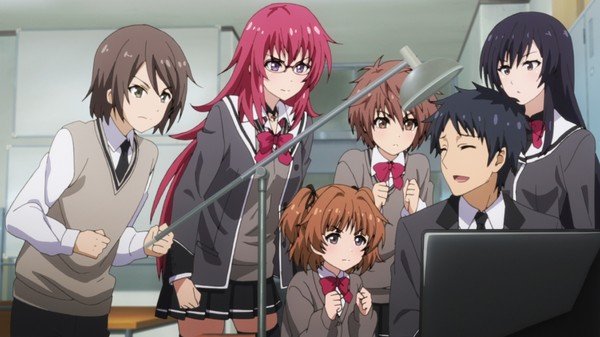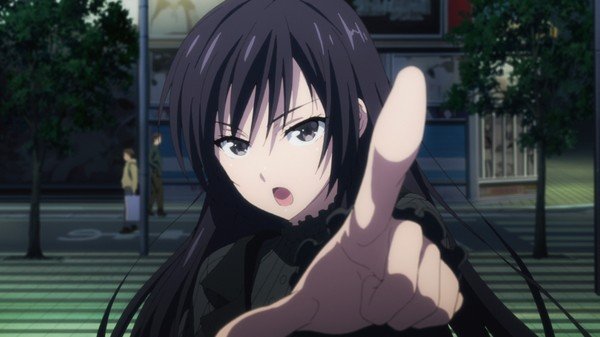D
darkstorm
Guest
Buntaro Hojo is your typical high school male student who has talent as a writer, lending his abilities to the drama club, but has no aspirations or desires for what he wants in the future. Enter Sayuki Kuroda, a quiet girl who randomly takes Hojo out for the day to get to know him and ask him one simple question: does he like bishojo (a.k.a. dating sim visual novel) games? Sayuki has a master plan to make her own game and have it be a major success across the genre, so she wants Hojo to write the story for it. Shortly afterwards, the pair recruit the rest of the team from voice artists to programmers, but do they have what it takes to make an amazing bishojo game in such a tight turnaround?
It’s an easy mistake to make, considering that they were released close together, but Girls Beyond the Wasteland is NOT based upon a visual novel, in fact the anime debuted 3 months before the game was released. Regardless of which came first, there is an intriguing meta quality to the premise: high school kids making their own dating sim game when in fact the characters are in one themselves (if you’re playing the game that is) and thankfully the self-referral side is not exclusive to the synopsis as it carries over into the story. This is where the 12-episode series shows most potential; for example, in Episode 7 when Hojo gets writer’s block trying to write the confessional love scene, the girls each pitch an idea for how it can happen, even going as far as taking turns to re-enact it, complete with props and costumes. Not only does it give the opportunity for decent character moments but also shows the fun side of game development and explores/pokes fun at some of the more cliché elements of the genre. However, this is the only time when the idea truly blossoms because the rest of the series never escapes from the ‘wasteland’ it’s trying to go beyond. There are a few other instances where the series thinks it’s being clever, such as the beach episode (it’s even self-titled; ‘This is the So-Called Fanservice Episode’) where the girls decide to emulate the way female characters in games talk about their breasts and compare sizes in the bathroom for fanservice reasons. However instead of being a parody or exploring why such scenes exist, the section plays out in a completely conventional way with the girls acting exactly how a typical fanservice bit would go, with the males on the other side of the wall listening in and feeling confused. If you took out the one or two lines where they reference what they’re doing and why beforehand, it would be no different to any other boob-fondling bathroom scene in other anime.

Outside of these self-exploration scenes, the rest of the game development process is played straight and we follow their journey through from the original pitch stage to the first day of release, complete with trials and tribulations they must overcome. However, the lack of energy makes the process look and feel very boring; it’s a shame because it does show parts of the development that the audience might be interested in and not be aware of, such as how many stills you need per scene or time restrictions when recording voice-overs, but nothing is portrayed as exciting within the anime itself as there’s no wacky comedy to compensate for people staring at computers or an in-depth look at what the game actually looks like or what it’s fully about. This goes hand-in-hand with the bland characters; not only do they look commonplace but the personalities are run-of-the-mill from the shy artist, to the fiery red-head to the mysterious straight-faced dark-haired girl. The only character that stands out does so for the wrong reasons: the one other male in the group (Atomu Kai) has a quirk where he’s mostly portrayed as the ‘nice guy’ but as he was recently dumped by his girlfriend for being as such, he suddenly bursts into extreme anger and rants when he’s called it. This could have been a potential for decent comedy with the whiplash of emotions, but when he says lines such as ‘I hate 3D girls’ and wishing that all girls would ‘piss off and die’, he crosses the line from understandably upset to complete ********. The series tries to compensate for the lack of characterization by stirring up drama between the cast, such as Yuka (the girlhood friend of the male lead) having a secret crush on him and Ando (the red-head) clashing with Sayuki to the point that she walks out of the team, but these feel consistently forced as we don’t feel connected with the cut-and-paste characters, and it’s not helped by the fact that the latter example of Ando walking out is replayed 3 times across the series with diminishing returns.
Although the characters don’t look unique, they are easy on the eye and the backgrounds for the series are nicely detailed. The animation quality however leaves a lot to be desired with several off-model shots, repeated frames to cut corners, and stills used in many dialogue-heavy scenes. Not that there’s much to animate to begin with, as it’s all set within a high school and they spend most of their time either talking or staring at computer screens, but it’s a shame that the amount of effort put into the opening animation (with the high-spirited song ‘Wastelanders’ by Sayaka Sasaki) isn’t carried across into the main show.
The DVD and Blu-ray editions contains all 12 episodes of the series, but not the additional OVA, with clean opening and closing being the only additional features. Be aware also that this set is Japanese audio with subtitles only, meaning no English dub.
Girls Beyond the Wasteland sadly fails to live up to its title; it’s a barren series consisting of small glimmers of potential that never take off due to dull characters, poor comedy and failing to make what they’re trying to accomplish endearing or interesting at all. It’s not offensive (outside of Atomu) or so-bad-it’s-good, it’s just a meandering waste of animation.

Continue reading...
It’s an easy mistake to make, considering that they were released close together, but Girls Beyond the Wasteland is NOT based upon a visual novel, in fact the anime debuted 3 months before the game was released. Regardless of which came first, there is an intriguing meta quality to the premise: high school kids making their own dating sim game when in fact the characters are in one themselves (if you’re playing the game that is) and thankfully the self-referral side is not exclusive to the synopsis as it carries over into the story. This is where the 12-episode series shows most potential; for example, in Episode 7 when Hojo gets writer’s block trying to write the confessional love scene, the girls each pitch an idea for how it can happen, even going as far as taking turns to re-enact it, complete with props and costumes. Not only does it give the opportunity for decent character moments but also shows the fun side of game development and explores/pokes fun at some of the more cliché elements of the genre. However, this is the only time when the idea truly blossoms because the rest of the series never escapes from the ‘wasteland’ it’s trying to go beyond. There are a few other instances where the series thinks it’s being clever, such as the beach episode (it’s even self-titled; ‘This is the So-Called Fanservice Episode’) where the girls decide to emulate the way female characters in games talk about their breasts and compare sizes in the bathroom for fanservice reasons. However instead of being a parody or exploring why such scenes exist, the section plays out in a completely conventional way with the girls acting exactly how a typical fanservice bit would go, with the males on the other side of the wall listening in and feeling confused. If you took out the one or two lines where they reference what they’re doing and why beforehand, it would be no different to any other boob-fondling bathroom scene in other anime.

Outside of these self-exploration scenes, the rest of the game development process is played straight and we follow their journey through from the original pitch stage to the first day of release, complete with trials and tribulations they must overcome. However, the lack of energy makes the process look and feel very boring; it’s a shame because it does show parts of the development that the audience might be interested in and not be aware of, such as how many stills you need per scene or time restrictions when recording voice-overs, but nothing is portrayed as exciting within the anime itself as there’s no wacky comedy to compensate for people staring at computers or an in-depth look at what the game actually looks like or what it’s fully about. This goes hand-in-hand with the bland characters; not only do they look commonplace but the personalities are run-of-the-mill from the shy artist, to the fiery red-head to the mysterious straight-faced dark-haired girl. The only character that stands out does so for the wrong reasons: the one other male in the group (Atomu Kai) has a quirk where he’s mostly portrayed as the ‘nice guy’ but as he was recently dumped by his girlfriend for being as such, he suddenly bursts into extreme anger and rants when he’s called it. This could have been a potential for decent comedy with the whiplash of emotions, but when he says lines such as ‘I hate 3D girls’ and wishing that all girls would ‘piss off and die’, he crosses the line from understandably upset to complete ********. The series tries to compensate for the lack of characterization by stirring up drama between the cast, such as Yuka (the girlhood friend of the male lead) having a secret crush on him and Ando (the red-head) clashing with Sayuki to the point that she walks out of the team, but these feel consistently forced as we don’t feel connected with the cut-and-paste characters, and it’s not helped by the fact that the latter example of Ando walking out is replayed 3 times across the series with diminishing returns.
Although the characters don’t look unique, they are easy on the eye and the backgrounds for the series are nicely detailed. The animation quality however leaves a lot to be desired with several off-model shots, repeated frames to cut corners, and stills used in many dialogue-heavy scenes. Not that there’s much to animate to begin with, as it’s all set within a high school and they spend most of their time either talking or staring at computer screens, but it’s a shame that the amount of effort put into the opening animation (with the high-spirited song ‘Wastelanders’ by Sayaka Sasaki) isn’t carried across into the main show.
The DVD and Blu-ray editions contains all 12 episodes of the series, but not the additional OVA, with clean opening and closing being the only additional features. Be aware also that this set is Japanese audio with subtitles only, meaning no English dub.
Girls Beyond the Wasteland sadly fails to live up to its title; it’s a barren series consisting of small glimmers of potential that never take off due to dull characters, poor comedy and failing to make what they’re trying to accomplish endearing or interesting at all. It’s not offensive (outside of Atomu) or so-bad-it’s-good, it’s just a meandering waste of animation.

Continue reading...
